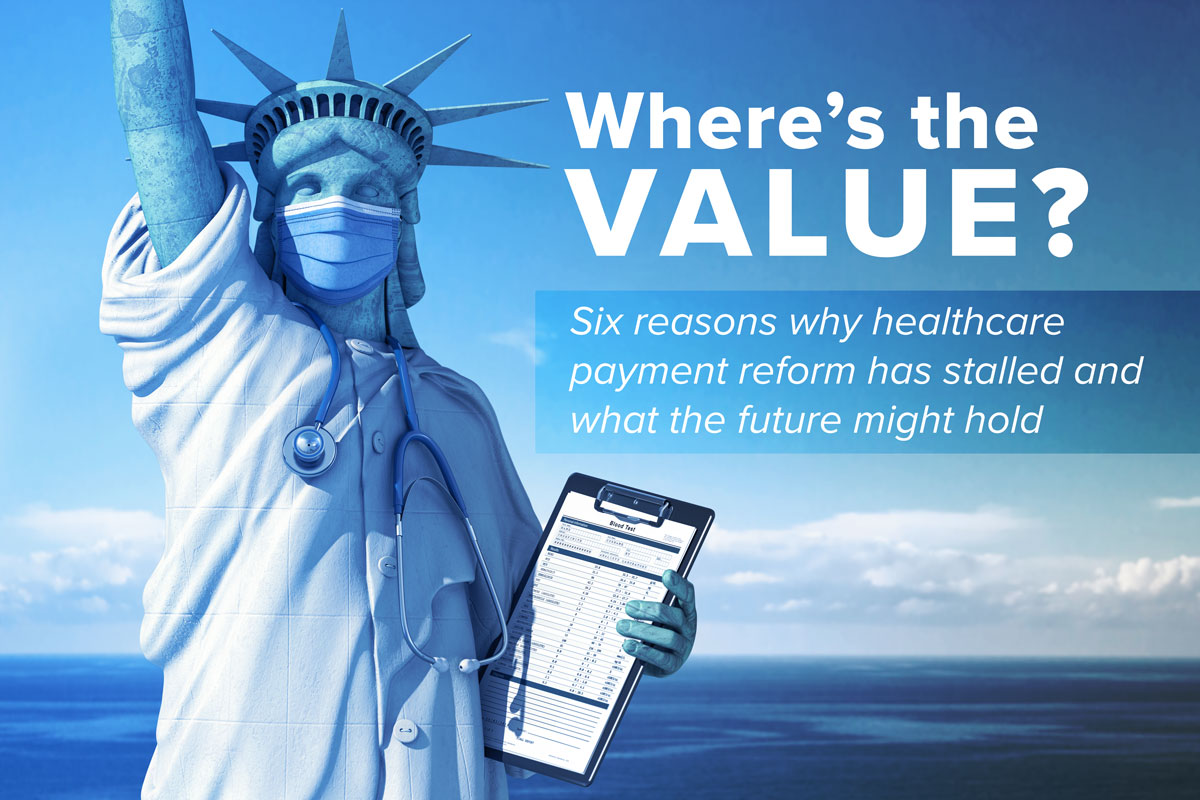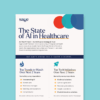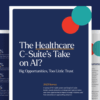For years, healthcare industry pundits have been predicting that we’re on the verge of a tipping point in value-based payment (VBP) and/or care. In a 2016 survey of 115 payers by ORC International and commissioned by McKesson, respondents predicted that VBP—such as pay-for-performance, global payment or capitation, and bundled payments—would make up at least 60 percent of payments by 2021.
That may have been overly optimistic. While one ostensibly might argue that the industry reached the tipping point in 2017, when 53 percent of commercial payments to doctors and hospitals involved value-based approaches, only 6 percent of total 2017 dollars entailed downside provider risk. Much of what passes for value-based payments is still built on a foundation of fee-for-service (FFS).
WHERE THE INDUSTRY CURRENTLY STANDS ON VBP
While CMS originated most of today’s alternative payment models, private payers appear to be taking on a greater percentage of the value-based pie. In 2020, over half of private plans offered bundled payments and ACO arrangements, vs. about a quarter of public plans, according to a survey conducted by Insights by Xtelligent Healthcare Media. Yet 83 percent of those survey respondents noted that fee-for-service remained the dominant payment method.
In 2021, most public payer VBP models still don’t entail downside provider risk. According to CMS, for example, 59 percent of Medicare Shared Savings Program participants are still upside-only (though this has improved from 2019 when 71 percent were upside-only).
The success of VBP programs is also checkered. On one hand, the oncology care program has largely been a debacle, while bundled payment programs have made joint replacement care more predictable with perhaps some gain in quality. A systematic review of the impact on costs, utilization, and quality from studies of three CMS bundled payment programs found these programs maintain or improve quality; however, only lower extremity joint replacement procedures saw lower costs.
A recent article in the New England Journal of Medicine examined the impact of a decade of operating the Center for Medicare and Medicaid Innovation (CMMI), which was funded by the Affordable Care Act at a cost of over $20 billion to spur new models. Author Brad Smith, CMMI Director, said that “value-based care will achieve its promise only if the federal government and stakeholders take more aggressive action to prioritize models that can truly achieve savings and improve quality.” The bottom line is that CMS doesn’t have a lot to show yet for the considerable time and money spent on such programs.
DATAGEN AND THE FUTURE OF VALUE-BASED CARE
One of our long-term partners, DataGen, a New York-based healthcare analytics company, conducted a study to take stock of industry adoption of value-based programs, benefits, and anticipated changes.
Here’s what they found:
- On average, 25% of healthcare organizations’ revenue is tied to value-based payments
- While most respondents are seeing some quality improvements as a result of their value-based efforts, the financial improvements have not kept pace.
- Over 60% of respondents plan to enter into or expand VBP participation in the next 1 to 2 years, and 50% of respondents believe VBP will become the primary revenue model for the U.S. in the next 5 years
WHAT’S SLOWING VBP PROGRESS?
Why has the predicted tipping point not yet arrived? There appear to be multiple factors working against the shift, including:
- Entrenched payment models
- Competing priorities
- Care delivery changes are slow
- Immature analytics, risk assessment, and decision tools
- Complexity
- Lack of transparency/interoperability
ENTRENCHED PAYMENT MODELS
Reforming the FFS, sick care–based U.S. healthcare system has, unsurprisingly, proved to be a slow and painful process akin to turning an oil tanker. The number of stakeholders is huge, and each has vested interests in preserving their slice of the healthcare pie. Changes have been largely incremental rather than revolutionary. And it’s not just on the provider side. Many of the hospital executives we’ve interviewed in the past few years have complained that they can’t move faster because the key payers in their market are reluctant to support such efforts.
COMPETING PRIORITIES
We know from our conversations with providers and plans that, despite significant efforts to embrace VBP, healthcare executives face other, competing priorities due to various industry changes. An early 2020 poll of 25 hospital CEOs and six payer CEOs, for example, found that while executives viewed VBP as a significant driver of industry changes, they ranked it below other change drivers such as ongoing shifts in care settings and more proactive consumers.
CARE DELIVERY CHANGES ARE SLOW
The healthcare industry is notorious for moving slowly, and VBP is no exception. The ACA promised healthcare reform and delivered insurance reform. Changes in insurance reform ensured more people are covered in a system that is still largely broken. True healthcare reform, where providers are focused on delivering consistent, integrated care with predictable results, can only happen when payment for healthcare services incents those outcomes in a bigger way.
IMMATURE ANALYTICS, RISK ASSESSMENT, AND DECISION TOOLS
We’re still climbing the rather steep maturity curve for collecting and using our mountains of data in timely and meaningful ways. While we’ve made progress in assessing member and patient risk, we continue to face massive challenges in finding and proactively treating those with risk factors such as diabetes, cardiovascular conditions, or behavioral health issues. As artifical intelligence (AI) grows in acceptance and adoption, this should improve.
COMPLEXITY
There are too many models, too much complexity, and too many metrics. One problem is that ‘value based’ has a broad range of meanings. Is it truly value-based when providers are paid on a FFS basis but eligible for bonuses and at risk for penalties if they don’t meet certain quality metrics? Physicians, hospitals, and health systems have a different set of payment and quality rules for different populations of patients. Keeping track of that and adjusting how you treat a patient based on those rules is neither feasible nor okay. Simpler payment rules, allowing for consistent and repeatable delivery of care for all patients, will help push true healthcare delivery reform.
LACK OF TRANSPARENCY/INTEROPERABILITY
Many providers are struggling to succeed and adapt to VBP models due to poor data transparency and interoperability barriers. In a 2018 survey, 74 percent of financial executives in large hospitals said they need to become better at both external and internal data sharing within the next three years to succeed in value-based care. The survey also found that provider executives believe payers can improve value-based adoption by sharing more of their data with providers. While gains have been made in both these areas since 2018, there’s still a lot of room for improvement. “Data rich and insight poor” is a phrase that has been around for way too long. Given the technology available today, access to and use of data to further healthcare reform and better delivery of care ought to have been solved well before today.
OLIVE FINDS HEALTHCARE AI AND AUTOMATION POISED TO TAKE OFF
SGP recently conducted a survey of 100 healthcare executives on behalf of our AI and automation partner, Olive. Executive awareness and adoption of AI and automation has grown measurably in just one year, although most organizations are early in their adoption process. Only 24% have moved beyond the pilot stage, and only 7% say they are fully operational.
But the fact that 90% say they have a strategy, this area looks poised to take off.
WHERE WE GO FROM HERE WITH VBP
While progress toward VBP has been slower than many expected, if 2020 taught us one thing, it’s that the healthcare industry can move much more quickly than we ever expected. Just consider the rapid expansion of payment for telemedicine services by payers, quick implementation of virtual care models by providers, and the lightning speed at which highly effective COVID-19 vaccines were created.
Whether VBP will experience a similar trajectory or continue to slow its pace in the years ahead remains to be seen. Some industry experts believe the pandemic will accelerate capitated payment models because providers already in these arrangements weren’t adversely affected by the plummeting patient volumes during COVID-19. Others, however, believe the pandemic will decelerate VBP growth. A recent survey of over 200 ACOs by the National Association of ACOs revealed that 77 percent are very concerned about the pandemic’s impact on their 2020 performance and that 44 percent are likely/very likely to leave their risk-based model due to these concerns.
Regardless of where VBP is heading, we are encouraged by ongoing efforts among payers and providers to improve the quality of care and reduce costs, as well as by health IT companies that continue to create innovative new tools that can support those efforts. Even if we never fully reach the VBP tipping point, the industry has learned valuable lessons over the past few years that will continue to move us closer to achieving that triple aim of improved quality, lower costs, and a better patient experience.
PREALIZE PREDICTS IMPACT OF DEFERRED CARE
Prealize Health, a predictive analytics company, conducted a claims analysis of healthcare utilization decreases to help providers and payers better identify patients at risk and predict future care needs.
Their analyses predicted that 2021 deferred screenings and care will increase across three core areas:
- Cardiac disease
- Cancer
- Fractures
- Predictive analytics, automation, and AI are maturing to the point where they can help providers more confidently manage risk and make meaningful gains in efficiency–winners will be those who keep their eye on harnessing the value of these tools in taking the plunge to two-sided risk.
- With the U.S. spending trillions to recover from COVID and reduce socioeconomic inequalities in our system, the pressure on healthcare organizations to cut costs can’t be put off forever. Payers and providers alike will have to embrace payment and care models that reward better health at lower costs, such as hospital-at-home programs, bundled payments, and capitation.






